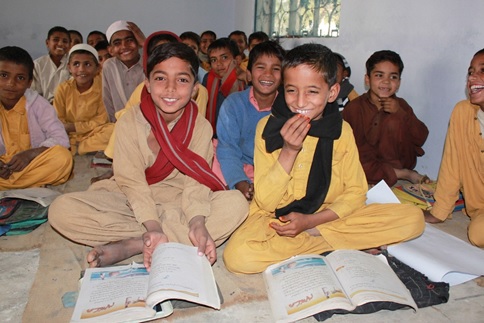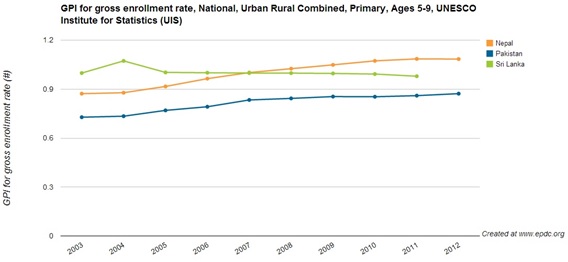You are here
EPDC Spotlight on Pakistan
EPDC Spotlight on Pakistan
Each week, the EPDC Data Points blog will highlight a different country and the resources we offer, such as data, country profiles, research or other tools that users have available to them through the website. Our third post in the series highlights Pakistan, and we provide an overview of education in the country and the data resources we have that are publicly available.
Pakistan is a lower middle income country in South Asia with a population nearing 200 million people, making it the 7th most populous in the world. Despite Pakistan’s stated commitment to achieving the Education for All and Millennium Development Goals (MDGs) by 2015, improvements in education indicators have come slowly. The Pakistani Ministry of Education, Trainings, and Standards in Higher Education attributes this slow progress to disruptions in provision of education due to a devastating earthquake in 2005, tumultuous political transition throughout 2007 and 2008, and debilitating flooding during August 2010 and 2011. However, the government recognizes the need to recover from this turmoil in order “to accelerate progress towards ensuring that all children attend school and learn.”
Pakistani Students in a Rehabilitated Primary School following Flooding (United Kingdom Department for International Development)

In principle, Pakistani primary and secondary school attendance is free and compulsory. Children are admitted to primary school above the age of five. After completing five years of primary school, three years of lower secondary school, two years of secondary school, and two years of higher secondary school, students can apply for admission into university. Alternatively, students can complete vocational training programs.
Learning Outcomes
Pakistan has a well-structured system of assessments taken at transitional points in students’ education. At the conclusion of primary school, students take an examination for promotion to secondary school and award of merit scholarships. Upon completion of secondary school and higher secondary school, students sit for the Secondary School Certificate Examination and Higher Secondary School Certificate Examination respectively. Each of the secondary school examinations map to six of the seven domains deemed important for learning by the Learning Metrics Task Force (LMTF). Discussion on the ongoing relevance of the LMTF can be found in the Education Policy and Data Center (EPDC) Data Points blog post Measuring learning: Where do we stand and where do we go?
Additionally, under the guidance of the South Asian Forum for Education Development, the Annual Status of Education Report (ASER) has been replicated in Pakistan. ASER is a household based survey on basic learning in reading and arithmetic. In the 2010 ASER assessment, the percentage of first grade pupils reading at or above the lowest performance benchmark ranged from 62 percent in Sindh to 93.6 percent in Azad Jammu and Kashmir (Figure 2). These disparities across regions and the 2011 dissolution of the Pakistani Ministry of Education leads to a question about ways to improve educational equity across autonomous provinces. More information on the EPDC learning outcomes benchmark indicators is available on the EPDC learning outcomes data landing page while spreadsheets with content-specific indicators for ASER assessments are available for download.
Figure 2: Percentage of Pupils at or above the Lowest Performance Benchmark in Urdu
Education Data: A Snapshot
In Pakistan, the 2011 literacy rate is 42 percent for women over age 15 and 67 percent for men over age 15. Across both genders, just over half of Pakistanis over age 15 are literate. However, 70.8 percent of young adults between the ages of 15 and 24 are literate in Pakistan. Rising rates of literacy among youths points to a populace that is increasingly able to engage in society and to learn.
EPDC estimates for 2014 show the primary school gross enrollment rate in Pakistan is 82 percent for girls and 96 percent for boys.[i] By 2025, EPDC Projections from Pakistan approximate that 94 percent of girls and 98 percent of boys will be enrolled in primary school. The 12 percentage point increase in the primary school enrollment rate for girls points to progress in girls obtaining access to basic education, a persistent problem in Pakistan. Nonetheless, this projected progress would fall short of the achieving universal primary education, a goal which Pakistan sought to achieve a decade prior. The EPDC website hosts a wealth of data on education in Pakistan including: demographics, educational expenditure, literacy, and gender parity. More detailed descriptions of Pakistani education can be found in its Education Profiles and in over a dozen Pakistan District Education Profiles which include district-level information and projections on teacher need, pupil-teacher ratios, and other indicators.
Issues of Educational Quality and Equity
Pakistan has struggled to devote resources to education while managing relief efforts and expansive military spending. In fact, public spending on education is a mere 2 percent of gross domestic product and about 10 percent of all government spending. This partially explains why education in Pakistan lags behind education in other South Asian nations.
These regional disparities are most stark in reference to girls’ education (Figure 3). However, between 2004 and 2011 the International Development Agency of the World Bank extended over $1.1 billion to support increased educational investment, with an emphasis on the inclusion of girls. Efforts to include girls have often taken the form of school stipends. Although these stipend programs have been useful, girls seeking an education in some regions of Pakistan still face the threat of violence from the Taliban. Such intimidation suggests that government and communities must make an effort to protect girls as they pursue an education.
Figure 3: Gender Parity Index (GPI) for Primary School Enrollment
In Pakistan, there is also movement towards utilizing madrassas, traditionally Islamic religious schools, as a tool by which to offer poor children both a religious and modern education. In March 2014, Pakistan announced a plan to bring all madrassas under its national education system. Conservative estimates find that Pakistan is home to about 20,000 madrassas servicing over two million pupils. Many of these religious institutions have been viewed as breeding grounds for religious extremism which fail to offer students an education which leads to marketable job skills. However, for the 88 percent of madrassa students who are from poor families, the religious schools offer room, board, and some education. The recent attempt to integrate Pakistani madrassas into the traditional education system seeks to address these issues of educational quality and extremism by modernizing curricula.
EPDC Resources
Among other sources, unique EPDC data collections for Pakistan include data from the Bureau of Statistics (2006-2009), the Ministry of Education (2006, 2009-2012), USAID Demographic and Health Surveys (2007), Pakistan Integrated Household Survey (1998, 2001, 2005), Pakistan Social and Living Standards Measurement Surveys (2005-2008), Annual Status of Education Report (2010-2012), and other indicators derived from the UNESCO Institute for Statistics. EPDC users can anticipate an upcoming extraction of the 2013 USAID Demographic and Health Survey on the website. The EPDC website offers users the opportunity to create graphs, charts, and other visualizations of data with an easy-to-use tool.
[i] Gross enrollment rates are calculated as: total enrollment in a specific level of education, regardless of age, expressed as a percentage of the official school-age population corresponding to the same level of education in a given school-year. The figures are often higher than 100 percent because of repetition and overage students.

.jpg)

Add new comment